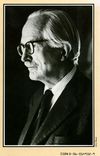Fear to Tread
Fear to Tread is a mystery–crime thriller by the British mystery writer Michael Gilbert, first published in 1953 by Hodder & Stoughton in England and by Harper & Row in the United States. Set mostly in London, it was his seventh novel in six years and built upon the favorable reputation he had achieved earlier with the well-received Smallbone Deceased and Death Has Deep Roots. Its main character is Wilfred Wetherall, a middle-aged, mild-mannered headmaster of "an understaffed, overpopulated secondary school for boys in the south-east of London." To further emphasize the apparently unheroic nature of the protagonist, throughout the book the third-person, omniscient narrator refers to him as "Mr. Wetherall". The book's plot is the gradual discovery by Mr. Wetherall that even a number of years after the end of World War II there is a flourishing black market in London for rationed food and other items, most of them stolen by one gang or another and then "redistributed" for their profit to restaurateurs and catering services. The gangs responsible for these activities are directed by a well-concealed master criminal and all of them are totally ruthless when it comes to protecting their identities.
In a long, admiring ''New York Times'' article about Gilbert by the mystery writer Amanda Cross she writes that:
His heroes fight without hope of reward, because they hate bullying; they honor, albeit with regret, the slow processes of democracy and law; they are loyal to those who have fought at their side, and they do not think trust a mug's game. In short, his characters embody the virtues of the class-ridden but romantic public school tradition.[1]
Chief Superintendent Hazlerigg plays an important role in the book but does not appear until page 154 of the 223-page British edition.
